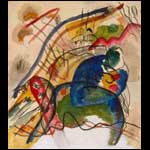
Study for painting with the white border 1913
Coll. Art Gallery of NSW © Vasily Kandinsky/ADAGP. Licensed by Viscopy, Sydney
Someone looks at an abstract painting. What does he or she ask? Probably “What is it?” or “What does it mean?”. The answer, “It’s only a picture, only a surface covered with paint,” will in no way satisfy.
It is impossible to eliminate the belief, even a hundred years after the birth of abstract art, even if one is an artist or an art expert, that any deliberate arrangement of marks must represent something. Let me demonstrate:
1. Find a picture of a face in an old magazine, preferably a face of someone famous.
2. Take a pencil (or pen).
3. Using the pencil, push in the ‘eyes’, until you create two holes in the paper.
How did you react? Did you feel that, somehow, you assaulted the ‘person’ in the photo? Did it seem to you that you were being just a little bit… evil? Why? I am sure that you don’t believe in voodoo, that you don’t create dolls of your enemies and push pins into them! But deep inside us all there is an ancient belief in voodoo, a belief that images have some power over the things they represent. You can see this when people get angry after someone destroys a national flag. And, of course, the flag in no way resembles the nation!
So, completely abstract, or non-figurative, art will never be fully accepted. However, this doesn’t have to worry us as, long as we understand the principle.
Esperanto:

Etudo por ‘Pentraĵo kun blanka rando’ 1913
Kolekto AGNSW © Vasily Kandinsky/ADAGP. Licencita de Viscopy, Sidnejo
Iu rigardas abstraktan pentraĵon. Kion li aŭ ŝi demandas? Verŝajne “Kio ĝi estas?” aŭ “Kio ĝi signifas?”. La respondo, “Ĝi estas nur pentraĵo, nur supraĵo kovrita per farbo” neniel kontentigos.
Estas neeble forigi la kredon, eĉ cent jarojn post la naskiĝo de abstrakta arto, eĉ se oni estas artisto aŭ artspertulo, ke iu ajn intenca aranĝo de markoj devas figuri ion. Mi demonstru:
1. Trovu foton de vizaĝo en malnova gazeto, prefere vizaĝo de iu fama.
2. Prenu krajonon (aŭ skribilon).
3. Per la krajono, puŝu en la ‘okulojn’, ĝis vi kreas du truojn en la papero.
Kiel vi reagis? Ĉu vi sentis ke, iel, vi atencis la ‘homon’ en la foto? Ĉu ŝajnas al vi ke vi estas, iomete, fiulo? Kial? Mi certas ke vi ne kredas je vuduo, ke vi ne kreas pupojn de viaj malamikoj kaj puŝas pinglojn en ilin! Sed profunde en ni ĉiuj estas praa kredo je vuduo, kredo ke figuroj havas ian povon super la aĵoj kiujn ili figuras. Ĉi tion vi povas atesti kiam homoj koleriĝas post iu detruas nacian standardon. Kaj, kompreneble, la standardo neniel similas al la nacio!
Ĉi tial, tute abstrakta, aŭ nefigura, arto neniam estos tute akceptita. Tamen, tio ne devas zorgigi nin, se ni komprenas la principon.